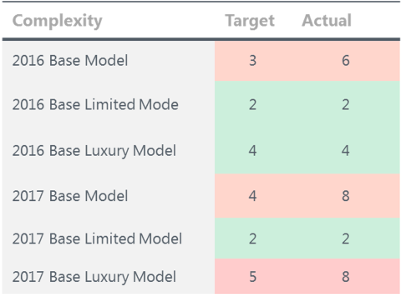Integrate Product Complexity Management and Decision Making


Product complexity management is very challenging for many manufacturing companies. Managing product variety and its resulting complexity is crucial for the success. Variety offered to the market place supports the goal of maintaining and increasing market share, revenue and profit. However, variety introduces complexity into the product portfolio, and in value-chain processes. Consequently, companies struggle with the trade-off between benefits and efforts of complexity from adding new variants.
My colleague, Sanjay Kulkarni, has been exploring how you can use a single configurator backbone for managing product complexity. Let’s continue that discussion with a look at how you can leverage the configurator backbone to evaluate complexity and integrate in decision making.
The process of integrating product complexity mangement in decision making begins with modularization of the problem. Systems can be decomposed into modules and an organization can start with management of complexity at the module level. As an organization matures, product complexity management techniques for a module can be extended for sub-modules. Teamcenter provides a rich set of capabilities to define and manage your product architectures.This includes reusable templates and the ability to manage your architectures as they evolve over time. It’s likely that you will want to manage views for different domains, such as system, physical, and functional breakdowns of your product.
Once architecture is established, you can use this as a guide to scope the variability that will be relevant to each node or module within the architecture. The number of desired variants for a module can be assigned as a target based on market study and benchmarking of competition products, this target is also known as complexity level.
You may have a target for the number of variants of a given module you intend to offer to the market.For example, if marketing determines that five variants of steering wheel are required, then one can assign a complexity target of five to the module steering wheel. Because the architecture allows you to plan a given module across your product suite, you assign multiple targets to the same module, and make them program or variant specific.

In order to understand and evaluate complexity for a module, it is necessary that relavant features for that module are known. Teamcenter enables the planning by providing capability to scope or organize features against the architecture modules they are relevant for..
A traditional approach to product complexity management is to build the complexity tree based on these drivers and product variability. These complexity trees tend to get difficult to manage. With Teamcenter, you can leverage variability organized under modules, module relationships and configurator constraints to identify the correct impacting variability and then compute the valid combinations.Once variability is organized under modules and complexity drivers established, Teamcenter can compute the combinations. These acutal complexity number can be then reported side by side to their target, for a given variant and for a given milestone.

Now you can manage complexity and perform real time reporting on actuals and compare them to the targets you’ve defined. Product decisions that result in increased complexity and typically drive higher costscan now be reviewed to consider the impacts before a decision is finalized. If the product proposals being considered would result in unaccptable costs or complexity, you can create constraints in product configurator to have the system keep complexity in check. Thisoverall decision process can be seamlessly integrated into your product development and change management processes.
Want to know more about what product configurator capabilities inside of PLM can do for you?
Take a look at some of these resources:
Rethinking Variability Management with Product Configurator Software inside PLM video
Beyond Product Configurator Software: Total Variability Management blog series
Guided Product Configuration blog
Product Configuration in Teamcenter
 About the Author
About the Author
A product manager at Siemens PLM Software for Teamcenter, Sanjay Kulkarni has over 23 years of experience in Configuration Management, Six Sigma, Product development and management.


